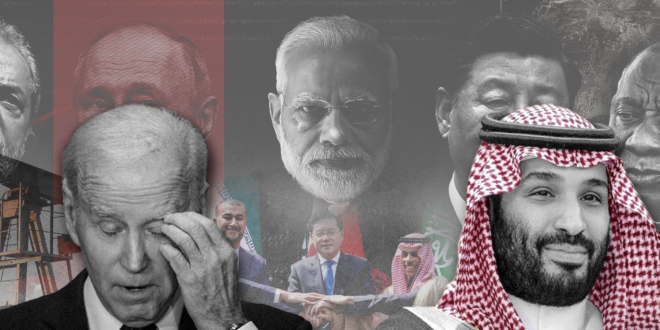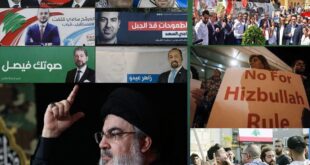Expect a ‘less-for-less’ outcome from any forthcoming US–Saudi security pact. Israel’s war on Gaza has hampered Washington’s plans to push normalization with Tel Aviv and pull Riyadh away from the Russia–China sphere of influence.
A historic security pact may be in the making between the United States and Saudi Arabia that could open a pathway to the kingdom’s normalization with Israel. Both sides are eager to close a deal that will replace their famous ‘oil-for-security’ bargain struck in 1945.
A caveat must be added, though. That 80-year-old agreement between president Franklin Roosevelt and King Abdulaziz Al-Saud has been tested in recent years as the global balance of power shifted and eroded some of their mutual trust.
With last decade’s Arab Uprisings, the once-reliable lines of communication between Riyadh and Washington became strained, and back channels diminished. Issues of reliability, due to trust deficit and waning US influence, began weighing down the once solid alliance. Three particular developments underscored that the pillars of the US–Saudi relationship had become shaky:
First, the creation of OPEC+, the brainwave of Russian President Vladimir Putin and Saudi Crown Prince Mohammed bin Salman (MbS), which launched an era of more independent production policy; second, Riyadh’s decision to join the multipolar BRICS and Shanghai Cooperation Organization (SCO); and third, the Saudi decision to normalize relations with Iran, a commitment formalized in a Chinese-brokered peace deal in March 2023.
The raison d’être of a renewed US–Saudi partnership is not in doubt. The dramatic events of 7 October 2023 in the Gaza envelope shattered the Biden administration’s notion that the Palestinian problem was “resolving itself” and that all that was needed was a neat Saudi–Israeli normalization.
Instead, the issue of Palestine roared back to the center stage of West Asian security, and there is no leeway left to hoodwink the region, dissimulate empathy for the Palestinian cause, or strut around as a Good Samaritan on the Arab street.
Equally, Iran played its cards efficiently to bring the Axis of Resistance to the forecourt, something that rattled the Gulf Arab regimes, which, in turn, also provided a window of opportunity for the Biden Administration to re-engage their old allies.
The linkage between regional ceasefire demands, the humanitarian crisis in Gaza, and calls for the release of Israeli captives held by Hamas has enabled Washington to regain its footing as the key interlocutor on the diplomatic track.
Nonetheless, it remains a slippery slope for the US to reinsert itself as the main influencer in the region. Too much has changed in West Asia and the world in the interim.
The broad strategy pursued by the Biden team is to nurture the new ecosystem around the Abraham Accords that Donald Trump patented by envisaging an Israeli–Saudi deal as the linchpin of a broader political agreement. The White House imagines this would pave the way for Gaza’s reconstruction and the establishment of a Palestinian state that would go a long way to integrate Israel into its Arab neighborhood while allowing Washington to turn its attention to the Asia–Pacific and Eurasia to impede China’s rise and erode Moscow’s capacity to provide strategic space for China on the global stage.
Rather than a robust strategy, the above is a breathtakingly ambitious pipe dream given Washington’s growing list of existential challenges: an economy under the weight of the unprecedented debt burden; counterstrategies by the Russia–Iran–China axis; the threat of “de-dollarization” gaining traction in the world economy as more and more countries in the Global South are experimenting with alternative currencies in their international settlement.
Conceivably, one of the prime considerations in the feverish American mind is to get Saudi Arabia and the UAE to disassociate from a coordinated assault on the petrodollar at the forthcoming summit meeting of the BRICS in Kazan, Russia, on 22–24 October – a meeting expected to be a game changer in the “de-dollarization” process.
The forthcoming summit in Beijing this month between President Xi Jinping and Russian President Vladimir Putin is set to prioritize the restructuring of the international financial order. The latest data released by the US Treasury on 17 April showed that China’s holdings of US Treasury bonds fell to $775 billion in February, a drop of $22.7 billion from just a month earlier. The Global Times argued that “the downsizing marks a structural adjustment of China’s foreign exchange reserves, impacted by factors including the country’s balance of external payments and the profits on US Treasury bonds.” It also concluded the following:
As the global trend toward de-dollarization has begun, many countries have accelerated diversifying their reserves by increasing holdings of gold and using local currencies for international payment. China’s gold reserves at the end of March reached 72.74 million ounces, a monthly increase of 160,000 ounces, marking the 17th consecutive month for the country to increase holdings of this asset.
The figures speak for themselves. As one insightful recent US media commentary points out:
No concrete plans were committed to or laid out [by BRICS], but merely verbalizing the idea on the world stage shifts the Overton window of what’s acceptable to discuss publicly when it comes to countering the dominance of the US dollar in trade. While no BRICS currency is imminent, the idea is out there and it’s no longer a harebrained and fringe concept.
Suffice to say, the US–Saudi negotiations for a security pact are today either poised for a thrilling finish on Riyadh’s terms – or may meander, unanchored, at least until after the US November elections (33 Senate seats and all 435 House seats are also up for election on 5 November).
A top Saudi commentator noted that “the entire region is on the verge of applying ‘final touches’ against the backdrop of the war in Gaza. This could either lead to an agreement that leaves some either falling off their high horse or running to the edge of the abyss. In both cases, they will pay a difficult price.”
An insightful report in the Guardian this week disclosed that although the US–Saudi draft agreements on security and technology-sharing are ready, uncertainty lies ahead as these agreements were intended to be linked to a broader West Asia settlement involving Israel and the Palestinians. Put differently, Prime Minister Benjamin Netanyahu has to be brought on board on difficult topics such as a permanent ceasefire in Gaza and the creation of a Palestinian state. And all bets are off if he launches an offensive on Rafah.
So it is entirely unsurprising that the Saudis are now “pushing for a more modest plan B, which excludes the Israelis,” writes the Guardian. From a geopolitical perspective, a watered-down plan B might still be found attractive by Biden’s diplomats as it “would cement a strategic partnership with Saudi Arabia that would keep encroaching Chinese and Russian influence at bay. [But] It is far from clear whether the administration – let alone Congress – would accept such a less-for-less outcome.”
Netanyahu is all but certain to regard a normalization deal with the Saudis at this point in time as “a minefield that cannot be crossed due to the political cost involved.”
There is a famous line from a satirical song written in 1931 by the Soviet songwriter Vasily Lebedev-Kumach, which roughly translates as “The paper is the most important thing in life / Keep it safe as long as you’re alive / As without a proper paper, you’re a mere bug.”
The late Mikhail Gorbachev lived to rue that he didn’t demand a “proper paper” on NATO expansion. Saudi Crown Prince Mohammed bin Salman should take Gorbachev’s regret as a cautionary tale.
 Eurasia Press & News
Eurasia Press & News


